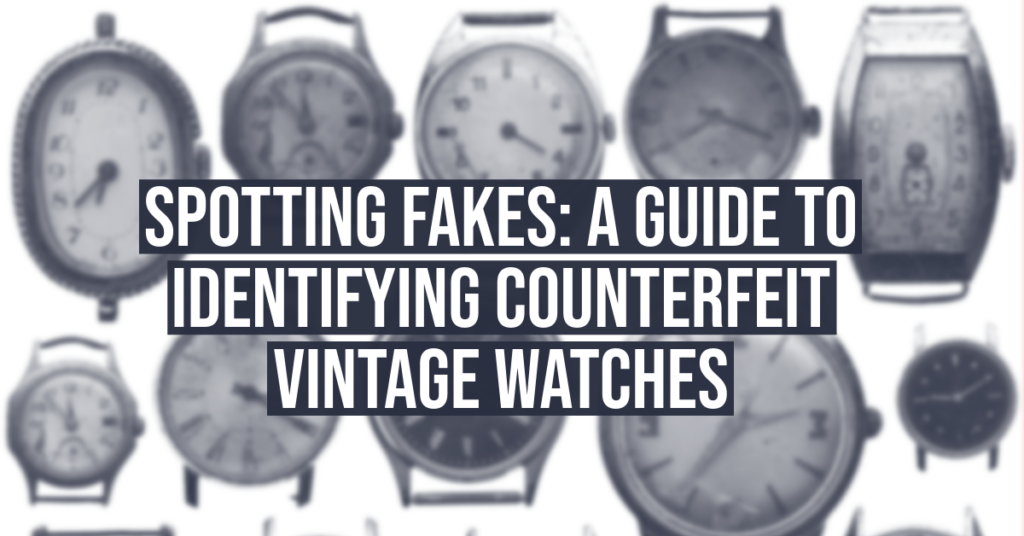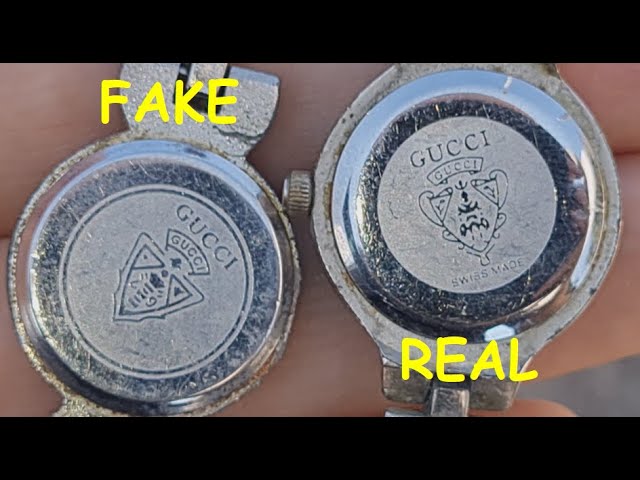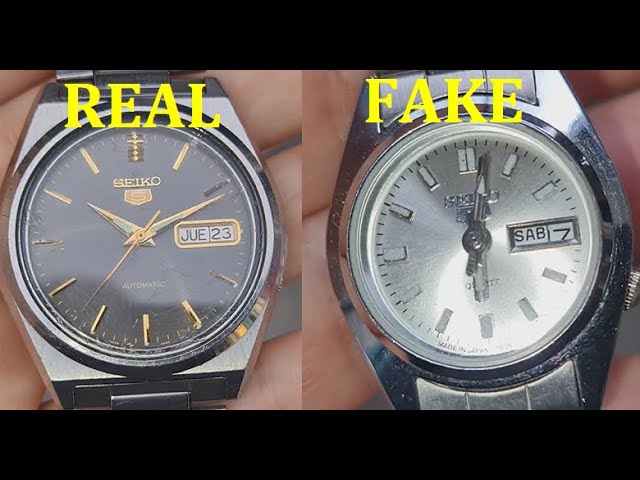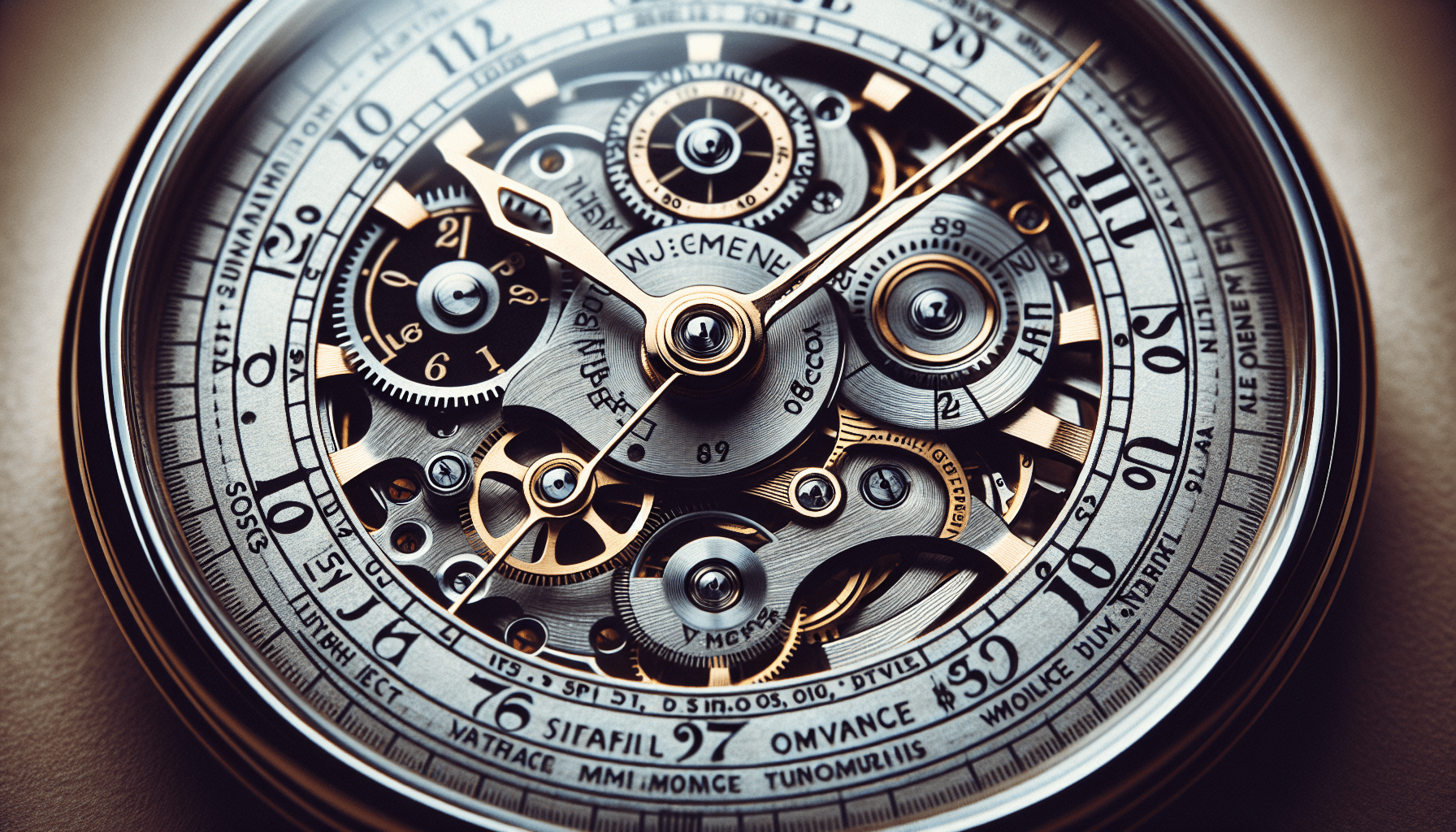So you’ve found yourself browsing through a collection of vintage wristwatches, captivated by their timeless charm. But how can you ensure that the one you’re eyeing is the real deal and not just a cleverly crafted replica? In this article, we will explore the key indicators that can help you recognize a fake vintage wristwatch. By understanding the subtle details and nuances, you’ll be able to confidently identify and appreciate the authenticity and value of these classic timepieces.

Check the Watch Brand and Model
When examining a vintage wristwatch for authenticity, the first step is to research the brand and model. It is crucial to familiarize yourself with the authentic brand and model information to be able to identify any discrepancies. Look for official brand documents or catalogs that provide detailed information about the specific watch you are inspecting. Pay attention to the characteristics that distinguish the authentic model from counterfeits or replicas. By gaining knowledge about the genuine brand and model, you will be equipped to spot any potential red flags.
Research the Authentic Brand and Model
Delving into the realm of vintage watches requires thorough research. Spend some time learning about the authentic brand and model you are interested in. Explore reputable websites, forums, and books dedicated to vintage watches. Look for historical information, specifications, and original advertising materials. This research will enable you to accurately compare the watch you are examining to the official brand information. By becoming well-informed about the particular nuances of the authentic brand and model, you will be better prepared to identify any inconsistencies.
Compare the Watch to Official Brand Information
Once you have gathered sufficient knowledge about the authentic brand and model, it’s time to compare the watch in question to the official brand information. Examine the watch closely, paying attention to key details such as the brand logo, model name, and any unique features. Look for any discrepancies or inconsistencies that may indicate a fake. Authentic watches often have specific characteristics that distinguish them from counterfeits, such as the font style and spacing of the logo. By carefully comparing the watch to the official brand information, you can determine its authenticity.
Beware of Brands and Models That Don’t Match the Authentic Lineup
One important aspect to be wary of when assessing the authenticity of a vintage wristwatch is the brand and model lineup. Some counterfeit watches are created using brand names or models that never existed or were never part of the official lineup. Pay attention to the authenticity of the brand and model you are examining, ensuring that they align with the genuine collection. If you come across a watch that claims to be from an authentic brand but doesn’t match any known models, exercise caution and consider seeking expert opinion or authentication.
Examine the Watch Dial
The dial of a vintage wristwatch can reveal many clues about its authenticity. During examination, inspect the dial for consistency in fonts and logos. Authentic watches meticulously adhere to a specific font style and logo placement, so any variation may indicate a potential fake. Additionally, look for signs of poor quality printing, such as blurred or uneven lettering, smudges, or inconsistent coloring. Misspellings or incorrect brand logos are clear red flags that the watch is likely not genuine.
Inspect for Consistency in Fonts and Logos
When examining the dial, one crucial aspect to focus on is the consistency in fonts and logos. Authentic vintage watches are known for their attention to detail, including precise font styles and logo embroideries. Compare the fonts and logos on the watch dial to reference images of authentic models. Look for any variations, inconsistencies, or irregularities that deviate from the standard design. A genuine vintage watch will exhibit a high level of consistency in the fonts and logos used.
Look for Signs of Poor Quality Printing
Another vital aspect to consider when inspecting the dial is the quality of the printing. Authentic vintage watches undergo meticulous printing processes that result in sharp, clear, and well-defined lettering and detailing on the dial. Look closely for any signs of poor quality printing, such as blurred or fuzzy lines, uneven lettering, or smudged logos. These imperfections are clear indications that the watch may be a replica or counterfeit. Genuine vintage watches often exhibit exceptional printing quality that is absent in fake versions.
Check for Misspellings or Incorrect Brand Logos
One of the most obvious signs of a fake vintage wristwatch can be found in misspellings or incorrect brand logos. Counterfeit watches often have subtle differences in the spelling of the brand name or feature incorrect logos that differ from the authentic counterparts. Take a close look at the dial, ensuring that there are no misspelled words or variations in the brand logos. Authentic vintage watches follow precise branding guidelines, so any discrepancies in this aspect should raise a red flag about the watch’s authenticity.
Analyze the Watch Case
The case of a vintage wristwatch provides valuable insights into its authenticity. A meticulously crafted case showcases the quality, materials, and design of the watch. Several key factors need to be examined when inspecting the case, including the case material and quality, correct serial numbers and engravings, and the match between the case design and authentic models.
Observe the Case Material and Quality
Authentic vintage watches are often constructed from high-quality materials that withstand the test of time. When examining the case, take note of the material used and assess its quality. Genuine vintage watches are often made from stainless steel, precious metals like gold or platinum, or durable materials like titanium. Counterfeit watches may use cheaper materials or have a poor finishing quality that suggests a lack of attention to detail. By observing the case material and quality, you can begin to assess the authenticity of the watch.

Check for Correct Case Serial Numbers and Engravings
A crucial aspect in determining the authenticity of a vintage wristwatch is checking for correct case serial numbers and engravings. Authentic watches have unique serial numbers engraved on the case back or lugs, which signify their individuality. Research the official brand information to find the correct serial number format for the specific model you are examining. Counterfeit watches often have incorrect or randomly generated serial numbers that do not match the authentic lineup. By verifying the case serial numbers and engravings, you can further evaluate the authenticity of the watch.
Ensure the Case Design Matches Authentic Models
The design of the watch case is another crucial aspect to consider. Authentic vintage watches exhibit a consistent case design across their models, with specific features and characteristics that set them apart. Compare the case design of the watch you are scrutinizing to reference images or authentic examples. Look for any variations or differences that deviate from the typical design. Genuine vintage watches maintain a harmonious and consistent case design throughout their production, while counterfeit watches may exhibit flaws or inconsistencies.
Inspect the Watch Hands and Markers
The hands and markers of a vintage wristwatch contribute to its overall aesthetic and functionality. When examining these components, it is essential to look for proper alignment and proportions, consistent and high-quality luminescent material (lume), and adherence to the authentic design.
Look for Proper Alignment and Proportions
Authentic vintage watches are renowned for their attention to detail, especially when it comes to the alignment and proportions of the hands and markers. Examine the watch closely, ensuring that the hands align precisely with the corresponding markers and subdials. Additionally, check for consistent proportions among the hands and markers, avoiding any irregularities or variations. Genuine vintage watches maintain precise alignment and proportional accuracy, while counterfeit versions may exhibit flaws in this regard.
Check for Inconsistent or Poor Quality Lume
Another vital aspect to inspect is the luminescent material, commonly known as lume, on the watch hands and markers. Authentic vintage watches often use high-quality lume that glows brightly and consistently in low-light conditions. Examine the watch under low light or darkness to assess the luminosity of the hands and markers. Inconsistent or poor quality lume that fades quickly or glows unevenly may indicate a counterfeit watch. Genuine vintage watches utilize lume that maintains its brightness over time, enhancing the legibility of the watch in all lighting conditions.

Ensure the Hands and Markers Match the Authentic Design
When assessing the authenticity of a vintage wristwatch, it is crucial to verify that the hands and markers match the authentic design. Research the official brand information to understand the precise design characteristics of the specific watch model you are inspecting. Compare the hands and markers of the watch to reference images or authentic examples, looking for any variations or inconsistencies. Genuine vintage watches adhere to the authentic design down to the smallest details, while counterfeit watches may exhibit deviations or flaws.
Verify the Watch Movement
The movement, often referred to as the engine of a watch, is a critical component that determines its accuracy and authenticity. When scrutinizing a vintage watch, it is essential to research the authentic movement for the specific model, observe the movement quality and finish, and be cautious of modern movements in vintage watches.
Research the Authentic Movement for the Watch Model
Each vintage watch model typically has a specific movement associated with it. Research the official brand information or consult reputable sources to identify the authentic movement for the watch you are examining. Pay attention to the movement specifications, such as the manufacturer, caliber, and any unique features. By gaining knowledge about the genuine movement, you can determine the authenticity of the watch you are inspecting.
Observe the Movement Quality and Finish
Authentic vintage watches boast meticulously crafted movements that showcase exceptional quality and finishing. When examining the movement, assess its overall quality, noting the precision of its components and the attention to detail in its finish. Genuine vintage watches often exhibit smooth mechanical operation, crisp finishing, and intricate decorations. Counterfeit watches, on the other hand, may have lower quality movements with rough finishes, cheap materials, or inaccuracies in timekeeping. By observing the movement quality and finish, you can make an informed judgment about the authenticity of the watch.
Beware of Modern Movements in Vintage Watches
In some cases, counterfeiters may attempt to deceive buyers by fitting vintage watches with modern movements. These modern movements may have higher accuracy or additional features, which can mislead unsuspecting buyers. It is essential to be cautious of vintage watches that feature movements that did not exist during the original production period. Research the specific model and its corresponding movement to ensure that the watch you are examining aligns with the accurate vintage specifications.

Check the Crown and Pushers
The crown and pushers are vital components of a vintage wristwatch, affecting both its functionality and authenticity. When inspecting these elements, it is crucial to ensure that they match the authentic design, observe their quality and finish, and verify their functionality.
Ensure the Crown and Pushers Match the Authentic Design
Authentic vintage watches feature crowns and pushers that align precisely with the authentic design specifications. Compare the crown and pushers of the watch you are examining to reference images or authentic examples to check for any variations or inconsistencies. Pay attention to details such as shape, size, engravings, and logo placement. Genuine vintage watches follow precise design guidelines for these components, while counterfeit watches may exhibit flaws or deviations.
Observe the Quality and Finish of the Crown and Pushers
The quality and finish of the crown and pushers provide valuable insights into the authenticity of a vintage watch. Genuine vintage watches often have well-crafted crowns and pushers with smooth and precise operation. Assess the quality of the materials used and observe the finishing, looking for any signs of poor workmanship, rough edges, or flimsy construction. Counterfeit watches often have inferior quality crowns and pushers that lack the attention to detail found in genuine vintage watches.
Verify the Functionality of the Crown and Pushers
Functional components are essential for a vintage wristwatch’s overall usability. When examining the crown and pushers, verify their functionality to ensure they operate as intended. The crown should wind smoothly and allow for time and date adjustment, while pushers should engage chronograph functions accurately. Counterfeit watches may have non-functional or poorly performing crowns and pushers, indicating a lack of authenticity. By checking the functionality of these components, you can further assess the watch’s authenticity.
Scrutinize the Watch Crystal
The watch crystal, often made from materials like sapphire or mineral glass, plays a crucial role in protecting the dial and ensuring the watch’s durability. When examining the crystal, it is important to check for authentic materials and shape, look for scratches or signs of poor quality, and ensure it does not fog or scratch easily.

Check for Authentic Materials and Shape
Authentic vintage watches utilize specific materials for their watch crystals to ensure durability and clarity. Research the brand and model to identify the authentic crystal materials used. Counterfeit watches may use cheaper or inferior quality materials that scratch easily or exhibit poor clarity. Additionally, examine the shape of the crystal, ensuring it matches the authentic design. Genuine vintage watches adhere to precise crystal shapes that are consistent with the specific model.
Look for Scratches or Signs of Poor Quality
Scratches or signs of poor quality on the watch crystal can indicate a replica or counterfeit. Authentic vintage watches often have high-quality crystals that resist scratches and maintain their clarity over time. Inspect the crystal closely, checking for any scratches, chips, or imperfections. Poorly manufactured crystals may have irregularities, bubbles, or noticeable flaws, suggesting a lack of authenticity. Genuine vintage watches typically exhibit clear and flawless crystals that enhance the overall appearance of the timepiece.
Ensure the Crystal Doesn’t Fog or Scratch Easily
Another important aspect to consider when scrutinizing the watch crystal is its resistance to fogging and scratches. Authentic vintage watches utilize high-quality crystals that have anti-reflective coatings and are resistant to both fogging and scratching. By exposing the watch to varying temperatures or humidity levels, you can determine if the crystal fogs easily, indicating a potential fake. Additionally, gently run your fingernail over the crystal’s surface to check for scratch resistance. Genuine vintage watches often have crystals that stand up to normal wear and tear without visible scratches.
Examine the Watch Bracelet or Strap
The bracelet or strap of a vintage wristwatch adds to its overall aesthetic appeal and comfort. When examining the bracelet or strap, it is important to research the authentic version for the watch model, check for proper brand hallmarks or engravings, and ensure it matches the authentic design.
Research the Authentic Bracelet or Strap for the Watch Model
Each vintage watch model typically has a specific bracelet or strap associated with it. Research the official brand information or consult reputable sources to identify the authentic bracelet or strap for the watch you are examining. Pay attention to details such as material, design, clasp type, and any unique features. By understanding the genuine bracelet or strap, you can accurately assess the authenticity of the watch.
Check for Proper Brand Hallmarks or Engravings
Authentic vintage watches often feature brand hallmarks or engravings on their bracelets or straps. These hallmarks signify the watch’s authenticity and add value to the timepiece. Examine the bracelet or strap closely, looking for any proper brand engravings or hallmarks in the correct locations. Counterfeit watches may have omitted or incorrect brand hallmarks, which is a clear indication of a fake. Genuine vintage watches pay close attention to detail, ensuring that brand hallmarks are precisely placed and accurately engraved.
Ensure the Bracelet or Strap Matches the Authentic Design
When assessing the authenticity of a vintage watch, it is crucial to verify that the bracelet or strap matches the authentic design. Research the official brand information to understand the precise design characteristics of the specific watch model you are inspecting. Compare the bracelet or strap of the watch to reference images or authentic examples, looking for any variations or inconsistencies. Genuine vintage watches adhere to the authentic design down to the smallest details, while counterfeit watches may exhibit deviations or flaws.
Beware of Suspicious Pricing
Pricing can often be a telling factor when evaluating the authenticity of a vintage wristwatch. It is essential to research the market value of the authentic watch model, be cautious of unbelievably low prices, and avoid sellers who avoid questions about authenticity.
Research the Market Value of the Authentic Watch Model
Before making any purchases, it is important to research the market value of the authentic watch model you are interested in. Understanding the typical price range for genuine vintage watches in the market can help you identify any suspiciously low or high prices. Compare prices on reputable marketplaces, auctions, and from reputable dealers to get an accurate sense of the watch’s value. If a seller’s price seems significantly lower or higher than the market average, exercise caution and investigate further.
Be Wary of Unbelievably Low Prices
If a vintage watch is being offered at an unbelievably low price, it is often a strong indication of a counterfeit or replica. Counterfeiters often try to lure buyers with unrealistically low prices, banking on their lack of knowledge or desire for a bargain. Remember that authentic vintage watches command a certain value due to their rarity, craftsmanship, and desirability among collectors. If a deal seems too good to be true, it often is. Exercise caution and question the authenticity of the watch before making a purchase.
Avoid Sellers Who Avoid Questions About Authenticity
When dealing with sellers, it is crucial to ask questions about the authenticity of the vintage watch you are interested in. A reputable seller should be knowledgeable, transparent, and willing to answer your inquiries. If a seller avoids or dodges questions regarding the watch’s authenticity, it raises a significant red flag. Genuine vintage watch sellers take pride in their offerings and are usually open to providing information and authentication support. Avoid sellers who exhibit evasive behavior and prioritize transparency when purchasing a vintage wristwatch.
Seek Expert Opinion and Authentication
When in doubt about the authenticity of a vintage wristwatch, it is advisable to seek expert opinions and authentication services from professionals in the field. Consulting professional watch collectors or dealers with expertise in vintage watches can provide valuable insights and guidance. Reputable watch experts offer authentication services, where they examine the watch thoroughly and provide a detailed report on its authenticity. For high-value vintage watches, certification from reputable experts adds credibility and enhances the watch’s value in the market.
Consult Professional Watch Collectors or Dealers
Professional watch collectors or dealers who specialize in vintage watches can offer invaluable guidance and expertise when assessing the authenticity of a vintage timepiece. These individuals have extensive knowledge and experience in identifying genuine watches and can help you navigate the complexities of the vintage watch market. Seek their advice, provide them with detailed information about the watch you are examining, and listen attentively to their insights. A second opinion from a seasoned professional can provide peace of mind during your authentication journey.
Request Authentication Services from Reputable Watch Experts
For a comprehensive assessment of a vintage wristwatch’s authenticity, consider engaging reputable watch experts who offer authentication services. These experts possess intricate knowledge of vintage watches and utilize various methods, including detailed examinations and research, to determine the watch’s authenticity. Authenticators often inspect multiple aspects of the watch, including dial, case, movement, and overall construction. Upon completion of the examination, they provide a detailed report and expert opinion on the watch’s authenticity.
Consider the Importance of Certification for High-Value Watches
For high-value vintage watches, obtaining certification from reputable watch experts serves as a crucial aspect of authentication. Certification enhances the credibility and value of the watch, providing assurance to potential buyers or collectors. Reputable authentication services often issue certificates, complete with detailed reports, photographs, and authentication signatures. These documents offer tangible proof of the watch’s authenticity, giving peace of mind to buyers and boosting the watch’s desirability in the market.
In conclusion, identifying a fake vintage wristwatch requires thorough research, careful examination, and knowledge of authentic brand and model information. By scrutinizing the watch’s brand and model, dial, case, hands and markers, movement, crown and pushers, crystal, bracelet or strap, pricing, and seeking expert opinion and authentication, you can confidently assess the authenticity of a vintage wristwatch. With patience, attention to detail, and reliance on reliable sources, you can navigate the world of vintage watches and make informed decisions when adding timeless timepieces to your collection.

